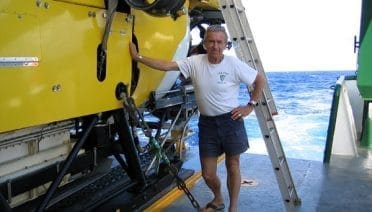Press Room
The U.S. National Academy of Sciences has selected Stanley Hart of the Woods Hole Oceanographic Institution as the 13th recipient of the Arthur L. Day Prize and Lectureship. Hart, a scientist emeritus in the WHOI Department of Geology and Geophysics, was recognized for making lasting contributions to the study of the physics of the Earth.
The motion, formation, and recycling of Earth?s crust?commonly known as the theory of plate tectonics?have long been thought to be continuous processes. But new research by geophysicists suggests that plate tectonic motions have occasionally stopped in Earth?s geologic history, and may do so again.
Lockheed Martin recently completed a Preliminary Design Review for the Replacement Human Occupied Vehicle (RHOV), a next generation three-person Deep Submergence Vehicle that will be used by the U.S. scientific community.
Within the month, the U.S. government must decide whether to list the polar bear as an endangered species. The question is: will such a declaration be too late because of climate change? A 2007 study by biologists, including Hal Caswell…
A sick or injured seal or dolphin is found stranded on a beach. Should limited marine mammal protection funds be spent to rehabilitate the animal, or would they be better used to increase public education, law enforcement, or research activities?…
Three senior scientists from the Woods Hole Oceanographic Institution will offer cautionary looks at the past and future of global climate change at the upcoming annual meeting of the American Association for the Advancement of Science (AAAS) in Boston. Lloyd…
More than a decade after fishing stopped near the Corner Rise Seamounts in the North Atlantic, researchers have found that the seafloor still has patches that are almost completely devoid of life. During an expedition to study deep-sea corals, Woods…
In selecting its “100 Top Science Stories of 2007,” the editors of Discover magazine recognized WHOI marine chemist Scott Doney and his colleagues for research on the effect of acid rain in coastal waters. The paper “Impact of anthropogenic atmospheric…
In the summer of 2007, engineers from WHOI’s Deep Submergence Laboratory proved they could operate an autonomous underwater vehicle (AUV) beneath Arctic ice. Six months later, the team will now attempt to operate two AUVs simultaneously in deep ocean waters.…
In the wake of the November 7 spill of 58,000 gallons of fuel oil into San Francisco Bay, environmental chemist Chris Reddy of the Woods Hole Oceanographic Institution (WHOI) has collected and analyzed oil samples to help assess the long-term…
Examining more than 50,000 seafloor images, geologists have created the most detailed map ever assembled for a volcanic eruption along a fast-spreading mid-ocean ridge. Researchers from the Woods Hole Oceanographic Institution, University of Florida, and University of Hawaii mapped where…
Penguins sing, are you listening? Lava flows, snow is glistening. Through the use of the Web and satellite technology, researchers and communicators from Woods Hole Oceanographic Institution are bringing the sights, sounds, and smells of the season that is, the…
Dr. Richard Garvine, a physical oceanographer who has specialized in the circulation of coastal waters and estuaries, has been named the 14th recipient of the Bostwick H. Ketchum Award from the Woods Hole Oceanographic Institution (WHOI).
King Abdullah University of Science and Technology (KAUST), a new world-class, graduate-level scientific research university now under development, finalized an agreement today with Woods Hole Oceanographic Institution (WHOI) to collaborate on marine research projects in the Red Sea.
The Board of Trustees of the Woods Hole Oceanographic Institution (WHOI) announces that Dr. Susan K. Avery has accepted the position of president and director of the institution.
Researchers from the Woods Hole Oceanographic Institution (WHOI) will host a public forum next week to discuss the pros and cons of ?iron fertilization? of the oceans as a means to mediate global warming.
Like forensic investigators hunting for strands of DNA at a crime scene, Maria Hansson and Brendan Foley have found a way to detect archaeological clues that are invisible to the naked eye. Hansson and Foley have developed a genetic technique to determine the original contents of amphoras, the ceramic vessels often used for transporting and storing goods in the ancient world.
On November 1, researchers from WHOI, the Scripps Institution of Oceanography, the National Oceanic and Atmospheric Administration, and the University of Washington?as well as collaborators from 22 other nations?will celebrate the deployment of the 3,000th operational float and the completion of the Argo armada.
Searching for better ways to protect this endangered species, a team of researchers from Florida turned to the Woods Hole Oceanographic Institution for help in understanding how the animals behave underwater.
For the past few decades, scientists have offered several competing theories for what led to the extinction of the Neanderthals, with much of the debate focusing on the relative roles of climate change versus conflict with modern humans. Now one theory can be ruled out. New research by a multidisciplinary, international team?including paleoclimatologist Konrad Hughen of the Woods Hole Oceanographic Institution?shows that Neanderthals did not die out at a time of extreme and sudden climatic change, as some researchers have suggested.

